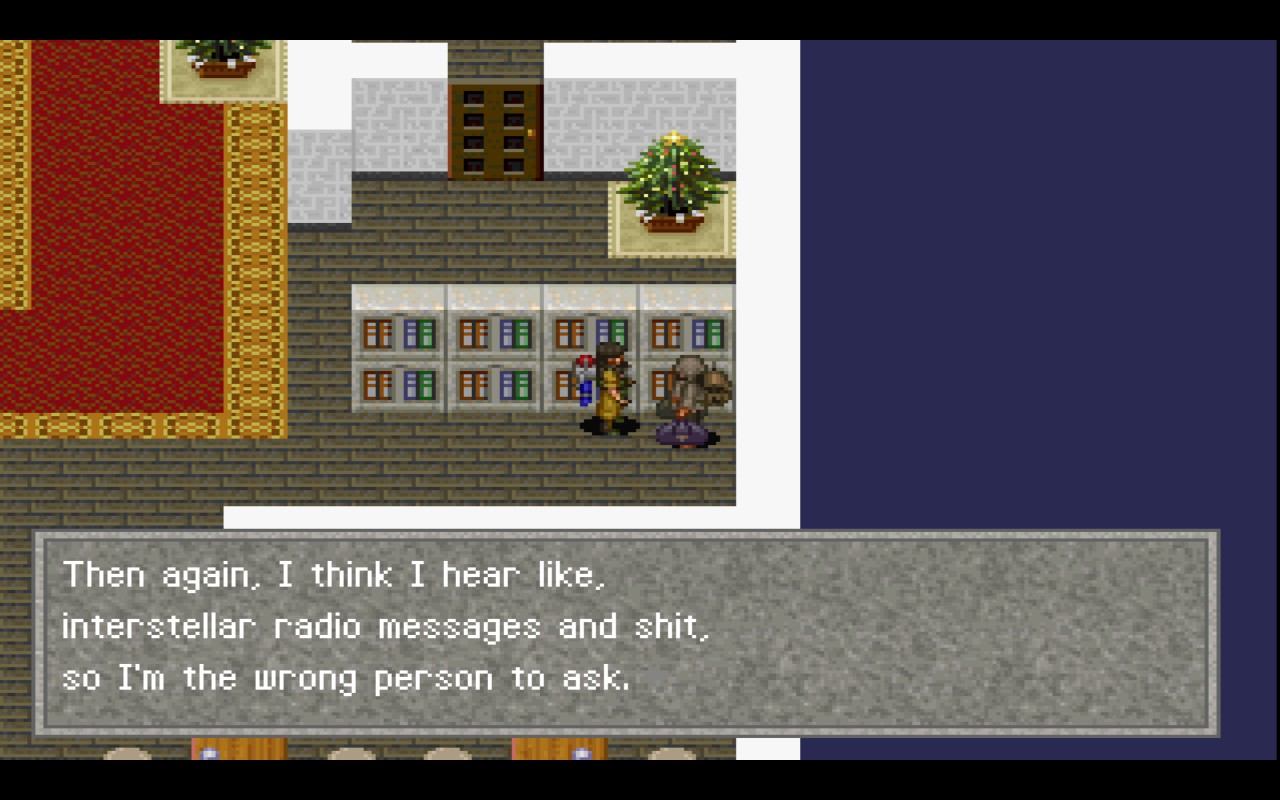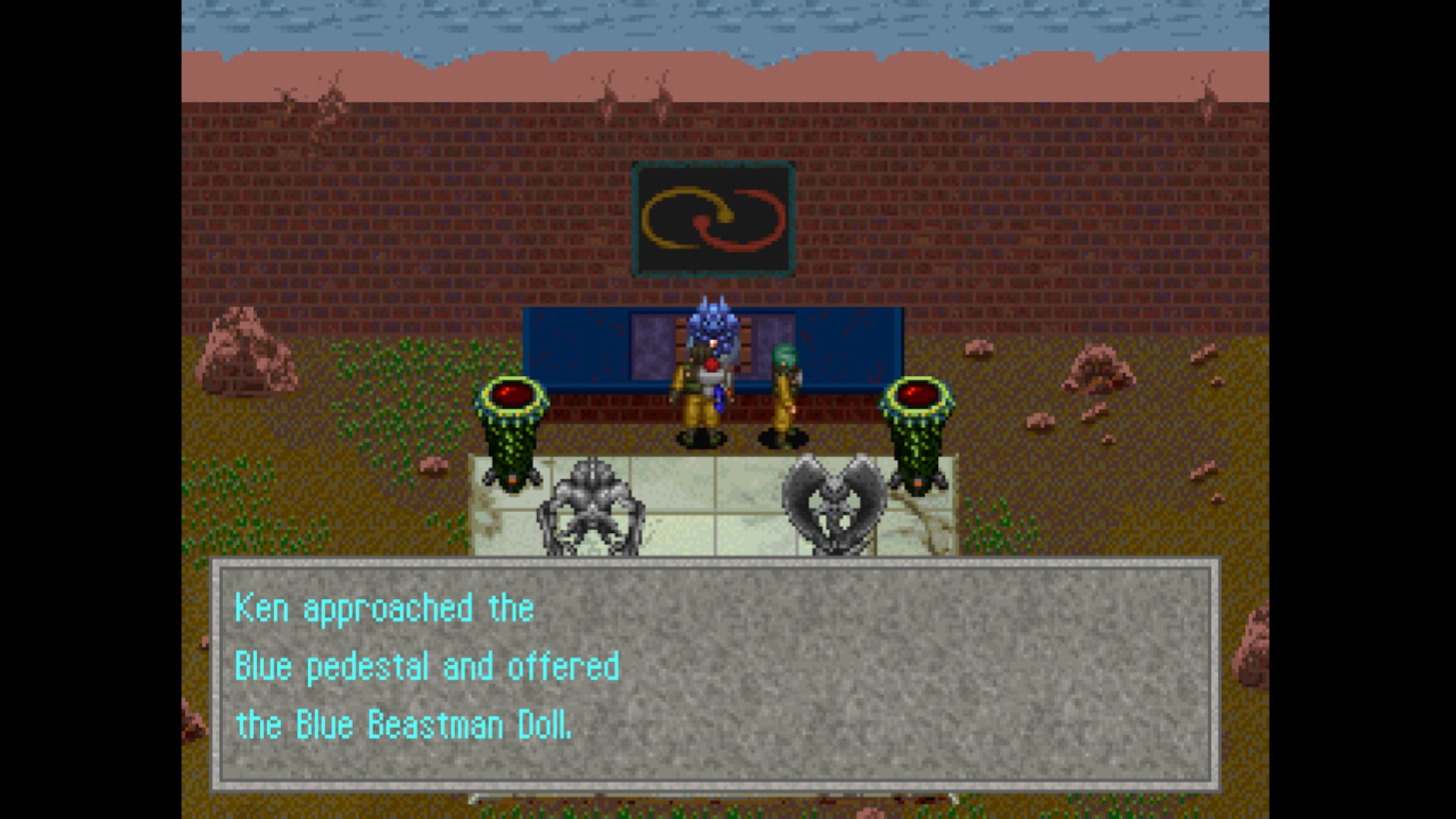posted: 2024-03-27
Admiring my Discoveries in Linda Cube Again
There are a multitude of secrets just waiting to be uncovered in Linda Cube Again. These might be silly NPCs who give a small clue about how to find a certain animal while simultaneously dropping one of the most unhinged set of sentences found in a video game. They might be the ways in which one might go about collecting a specific sex of animal in the game, like with one particular late-game animal where, in order to obtain a male version of this animal, the player must rip open a female version of the species to get an egg which must then be incubated for two seasons, and the whole collecting, ripping, incubating, and collecting process must be done before the egg incubator leaves the planet in 1998. These secrets might even be as simple as a swing set in an unexpected location. I list all of these examples, even if they all happen to be found should the player attempt a 100% completion 120/120 animal run of Scenario C, only to state that as I discovered each of these secrets, I found myself completely beside myself. I was amazed at how a game from 1997 could make me feel so emotionally invested in discovering such a dynamic range of its own pieces.
I got excited to find a dipshit who said he shouldn’t be taken seriously because he thinks he “hears radio messages and shit”.

Linda Cube Again has become one of my favorite games of all time and a large reason for its ascension has to do with just how much there is to find, without necessarily initially implying so. For all intents and purposes, Linda Cube Again keeps its cards entirely close to its chest throughout its first two “B-Movie Plot” Scenarios. Scenario A gave me a tour of the Northwest region, while Scenario B instead focused more on the Southwest region. In both scenarios, I was never so focused on putting all the spaces together, rather I spent my downtime between story beats occasionally looking around, maybe checking out the cave I saw in the mountain range just outside of town. I’d explore only long enough to capture a few animals before getting a new voicemail, which then directed my focus entirely towards the next story beat. This was Linda Cube Again’s deft slight of hand: The world wasn’t my focus, the characters were. The game actively distracted me from the depth of the world I was exploring by having these zany moments, and goofy character dramas in order to truly reveal the true depth of Neo Kenya only when I started to think that I had seen everything there was to see.
I am not a big “open world” gamer. I am often overwhelmed by the size of a world and frustrated by the feeling of having wasted my time if I play for an extended period of time with little-to-no progress. While I enjoyed The Legend of Zelda: Breath of the Wild well enough, my initial barrier to entry was the scale of the game. At Breath of the Wild’s launch in 2017, I was eighteen-year old college freshman swamped with classes; the idea of spending more than an hour simply exploring the sprawling kingdom of Hyrule felt like a waste of time (I had grades to maintain!). I didn’t start playing Breath of the Wild until the summer of 2020, and I had to do it on stream in a well-regulated, forcibly consistent space so as to not feel like I had misused my time if I was to only discover maybe a shrine or two as I traversed yet another grassy knoll. I quite enjoyed my time with Breath of the Wild, even during the moments of content-sparsity as they helped create a fascinating atmosphere, though I noted during most of the time I spent exploring what I saw on the horizon was rarely different when I continued my approach. What I saw was what I got.
The Legend of Zelda: Tears of the Kingdom has many flaws, but the one that ultimately drove me to postpone my playthrough was the fact that no matter where I went, I didn’t feel like I was making a truly exciting discovery for the amount of time I spent looking. My early notes detail that the only moments that truly elicited a “WOW” where when I first flew into the depths, and generally exploring any cave system. The former can be explained simply by the unexpected musical cue, and the latter be can attributed my general fascination with caves (caves are neat!). But the cave exploration grew stale rather quickly when each cave yielded a relatively similar pattern of treasures and collectables. By the time I paused my playthrough of Tears of the Kingdom, I was noticing just how long it was taking to get to places I already knew from my playthrough of Breath of the Wild, and how thoroughly “whelmed” I was upon reaching every “new” shrine. Each “new” discovery failed to make a lasting impact.
Scenario C of Linda Cube Again is about as close to an ideal “open-world” game I can think of that I’ve played in my twenty-five years of life. For one, travelling between spaces became quick and easy, albeit driven by intentionality from the game’s invisible timer. While the world was big, I was able to travel from one corner of the world to the other with relative ease. This ease of navigation meant could instead conduct more depth-first searches rather than the previously utilized breadth-first searches. And when I reached the bottom of the depth of these searches, I was always met with something new and exciting. At the bottom of the Sand Hole was a Beastman Necklace. In a crow’s nest in a maze-like abandoned hotel was a valuable, pilfered ring, the same ring I had, hours earlier in my gameplay, attempted to buy off of a haughty, pretentious woman. By placing the Blue Beastman Doll on the corresponding pedestal, I was met with-
well
maybe I shouldn’t reveal every little secret I found.

You'll just have to see what happened afterwards by playing the game for yourself.
What makes Linda Cube Again such a valuable open world gaming experience is the fact that I do not want to tell you want I found or how I found it. Sure, I’ll share that in my playthrough I found Giraffes, Lemurs and Whales, but I am not going to tell you how I found the Giraffe, Lemurs, or Whales. I explicitly do not want to tell you what happened when I placed the Blue Beastman Statue on the appropriate pedestal. This isn’t me being lazy (I’m publishing this writing to literally my own blog, I make the rules. You do not make the rules.), not knowing how to describe the experience. My reaction to this reveal was one of awe. “My mouth was agape for a solid minute.” as I posted in the goblin bunker’s #JRPG-diary channel. I was dumbstruck by a 16-bit game from 1997 in the year 2024. I wanted to stop and stare and just what I had discovered, what the game had revealed to me as a reward for being curious enough to play the same game three different times for in total more than thirty hours. But I couldn’t, of course. I was still on a time table. The invisible clock of Linda Cube Again kept ticking, and I still had to find 70 more animals.
But again, I do not want to tell you what I found during my playthrough of Linda Cube Again, because I want you to find it for yourself. I do not want to reveal the secrets of Neo Kenya, that’s not my job. I do not want to reveal what made me nearly tear up in the bottom floor of a dungeon in the Northwest corner of the map, because I want you to experience that feeling too. I understand this isn’t always the easiest ask, Linda Cube Again is absolutely not a game for everyone for a VARIETY of reasons. Many of the reasons in my opinion, happen to be moderately surface level, which is ultimately a shame. 1
There are very few games I’ve been able to play in my adult life that have not only surprised me, but made me adore their surprises. With the aforementioned Zelda games, I never really felt like I had hit any kind of exhilarating high upon discovering some little trinket, Korok Seed, or Shrine in the world. The ability to go to places I saw when I stood atop some towers was initially breath-taking, but by the third time I raised a tower and looked out on the horizon, the practice had become ordinary, commonplace. My expectations were never subverted. In contrast, every discovery in Linda Cube Again was exciting and special specifically because I had no idea what to expect next. And when I assumed I had seen all the tricks the game had to offer, the game threw back the curtain and revealed its greatest trick of all. And then it asked: “well, what’re you waiting for?”, and I snapped my awestruck jaw shut, and got back to business.
Yes, the JRPG turn-based combat will not satisfy people who are looking for high-strategy, or high-action combat environments. Yes, the initial two Scenarios are riddled with weird, often nonsensical, definitely suggestive, potentially taboo story beats that don’t really contribute to an obvious overall narrative. Yes, you do enact animal on animal violence with far less abstraction than Pokémon as the primary gameplay mechanic. and all of this is technically in an open-world game. I won’t deny this. If any entries on this sliding scale of reasons to not play a game resonate with you, I’ll understand.↩︎